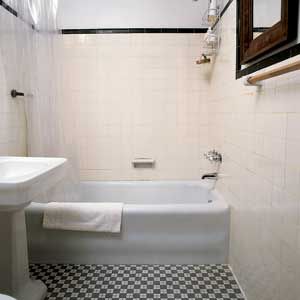
Years ago, the bathroom wall tiles in Kathryn and Geoffrey Precourt’s New York City apartment had been regrouted in the worst way possible. Someone had troweled on a mustard-yellow paste without first removing the old grout — and then failed to protect the new material with a sealer. Eventually the new layer began to stain, crack, and flake off, threatening to ruin a 70-year-old tile job. Halting this disaster-in-the-making meant scratching out all of the grout and starting over.
The one-day job fell to contractor Henry Borten, veteran of many tile
wars, and his crew of two. But before they started in, Borten did a little detective work, tapping on the tiles in several places and giving each wall a firm shove. “You need to listen to the tile and feel the wall,” he says, because cracked or crumbling grout lines can indicate serious water damage behind the tiles. A hollow thud is bad news. “It means that the water has attacked the glue, and only the tiles are holding each other in place,” says Borten. If the whole wall gives, he adds, the substrate is irreparably damaged, which only total demolition and retiling can fix. This Old House tile-guru Joe Ferrante agrees. “If the tile’s loose or the substrate’s damaged, regrouting is like putting a Band-Aid on a dying man.”
In the Precourts’ bathroom, Borten’s probing yields only good news, no
thuds or sponginess, so his crewmen, Jose and Jaime Chimborazo, father and son, start carving and scraping. Their tool kit contains specialized grout saws and carbide-tipped scoring tools, but both men mostly rely on standard utility knives. “Grout saws work fine on wide joints, but on thin joints the carbide grit can scratch the tile,” says Borten. Jose puts in a fresh blade as soon as his knife stops digging and starts skating over the grout.
After removing the grout, Jaime brushes the joints clean, and his father turns to the 3/8-inch-wide joint between the tile and the bathtub.
Standard grout isn’t elastic enough to bridge wide gaps, but Borten has
had success with the new polymer-modified grouts. “It’s easier to deal with cracked grout than failed caulk,” he says. Still, Borten has found a way to take the best from both worlds. Jose fills the gap halfway out with silicone latex caulk. Later on, he’ll fill the seam with the same silver-toned grout now being readied for the walls.
Jose prepares the grout with the aplomb of a chef who knows his recipes by heart. He adds water to the grout powder until it reaches the desired consistency, “something like warm butter,” Borten says. Jose sets the bucket aside for about 10 minutes, allowing the mixture of pigment, sand, and cement to chemically combine with the water, a process called slaking. After waiting, he stirs the grout one more time.
Once the grout is mixed, the clock starts ticking toward the time it
will harden in the bucket , or worse, on the wall. The Chimborazos know they can complete the job within the grout’s 30-minute setup time, but a novice should mix only enough for one wall at a time.
Jose spreads grout over the tile with a rubber-faced trowel, which packs
the joints without scratching the surface. He works the creamy mix at a 45-degree angle to the grout lines. Once they’re filled, Jose rakes off
the excess grout with the trowel’s soft edge. Jaime follows with a sponge, removing unwanted grout, shaving off high spots and smoothing the grout lines. When he finds a low point, he works in extra grout with
his finger.
After about 30 minutes, the grout begins to dry on the tile, and both
men switch over to sponges, cleaning the surface and being careful not to dig into the grout lines. “This isn’t rocket science,” says Borten. “The key is to clean everything up before the grout hardens.”
When the remaining moisture evaporates, any remaining cement particles will be deposited on the tiles. For stubborn spots, Jose pulls out a nonmetallic abrasive pad, but for most of the wall he buffs the surface with an old towel, putting a shine back on the old 4-by-4-inch tiles. In 24 hours, the grout will be ready for its inaugural shower.
Hue and Grout
Choosing grout doesn’t have to be a monochromatic experience. Manufacturers produce their grout powders in dozens of different colors, and many pair them with color-matched caulks. You can also mix powders to make your own color or order a custom blend directly from a manufacturer.
If you hope to match new grout to old, good luck. Like paint, it loses Pigment over time, and making a patch that blends in perfectly is equivalent to painting half a house and finishing the job three years
later. Your best bet may be to remove all the old grout and start from
scratch.
Or, you could do what Joe Ferrante’s wife, Ellen, did when she wanted to
change the look of her tiled foyer floor: Use a grout dye. Applied with
an artist’s paintbrush, one line at a time, only the grout , not the
glazed tile, absorbed the dye. Joe admits that the change looks terrific and that the application was much easier than removing the old grout. “But I wouldn’t do it for a million bucks,” says Joe. “It’s too much
like painting, which I hate. I do tile.”
